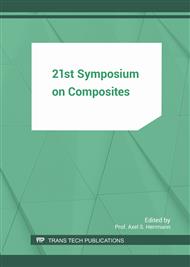p.9
p.17
p.25
p.31
p.38
p.46
p.54
p.62
p.70
Influence of the Manufacturing Process (Comparison MuCell and Direct-LFT) of Foamed and Fiber Reinforced Polymer Sandwich Structures on the Fiber Length
Abstract:
The automotive and aerospace industries ask for lightweight and cost effective materials, material combinations and structures for their products. To achieve these goals certain composite material groups have to be optimized with respect to their lightweight potential and production methods.Thermoplastic sandwich composites - which consist of a core structure (transferring the load) and two face-layers (absorbing tensile and compression loads occurring at bending) - suite the need of minimizing weight per area under bending loads. Reduction of process steps can be achieved by connecting the face layers and core in-situ via in mold assembly process using foam injection molding (FIM). FIM uses a single material system and – as within this work – physical blowing agents (PBA) for foaming. To increase the strength and stiffness of FIM parts, (long glass) fibers are in cooperated to create long fiber reinforced thermoplastic (LFT) materials.A commercially available version of the LFT-FIM process is the MuCell® process (Trexel, Inc.). LFT granulate (~ 11 mm length) is fed into the injection molding machine, melted and combined with nitrogen as PBA. To skip the needed compounding process step of the rod granules Fraunhofer ICT developed a Direct LFT-FIM process where polymer and continuous fibers are fed into a twin-screw extruder, melted and mixed with nitrogen. This single phase solution then is transferred to an injection unit.Within this work, these two foam injection molding processes will be compared concerning their achievable fiber length. For that purpose, (foamed) long fiber reinforced polypropylene (PP) blanks were manufactured using identical raw materials such as polymer, additives and glass fibers. The semi-finished product, starting material for the MuCell® process, were manufactured by EASICOMP GmbH using the same raw materials as with the D-LFT process. The different blanks – foamed and fiber reinforced PP (30 wt% and 40 wt %) – were manufactured using one injection unit for the MuCell® process and one for the D-LFT-FIM process. To compare the fiber length the same mold optimized to reduce fiber breakage was used in both processes.
Info:
Periodical:
Pages:
38-45
Citation:
Online since:
July 2017
Authors:
Price:
Сopyright:
© 2017 Trans Tech Publications Ltd. All Rights Reserved
Share:
Citation:


